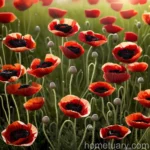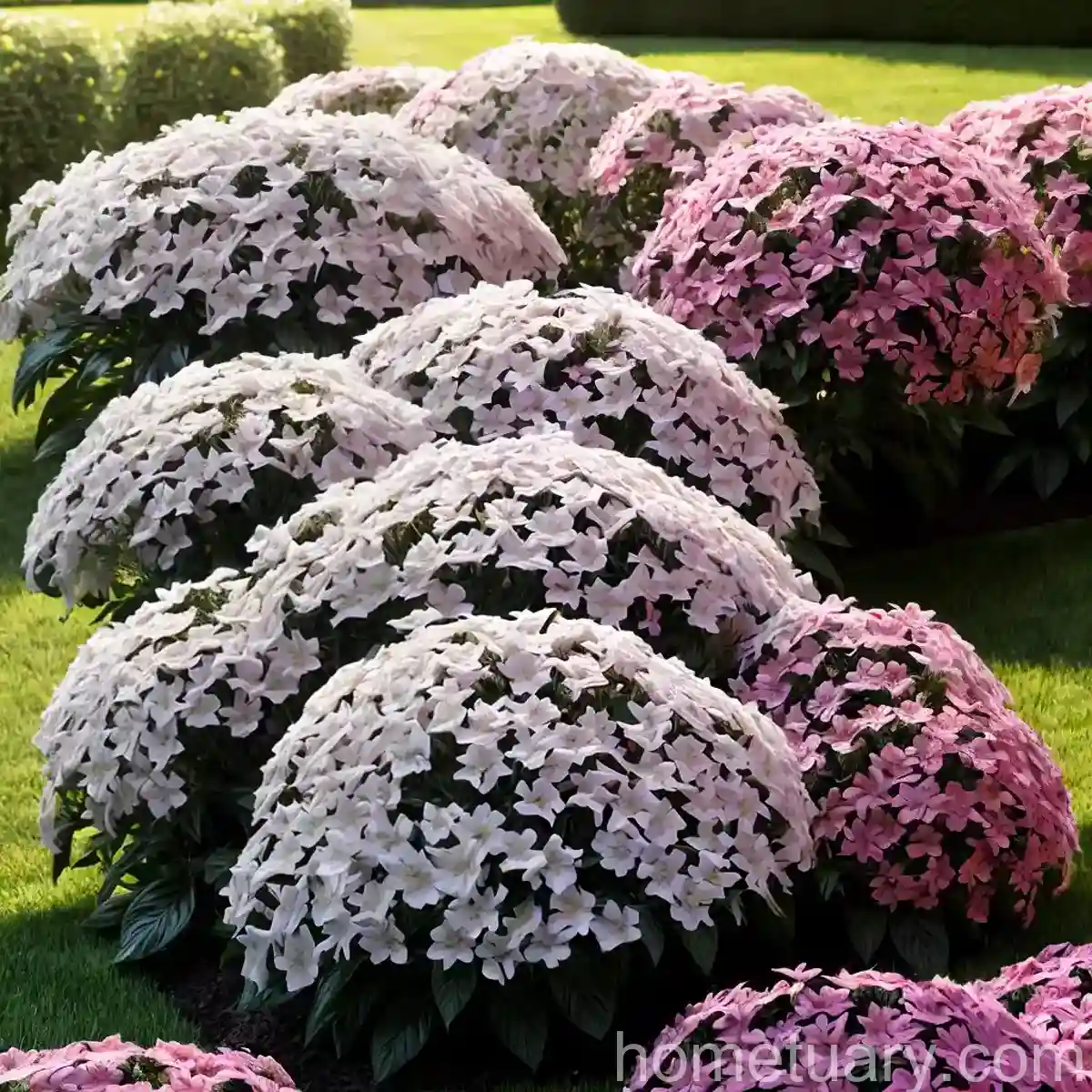The Oriental Poppy ‘Fatima’: A Delightful Addition to Your Garden
The Oriental poppy, scientifically known as Papaver orientale ‘Fatima’, is a stunning perennial plant that captivates garden enthusiasts with its vibrant and showy blooms. In this comprehensive guide, we will explore every facet of this enchanting flower, from its cultural requirements and maintenance to its uses in gardens and landscapes. Delve into the world of ‘Fatima’ poppies and unlock the secrets to successfully cultivating and enjoying these beautiful plants in your own outdoor space.
What is the Oriental Poppy ‘Fatima’?
The Oriental poppy ‘Fatima’ is a popular variety of Papaver orientale, celebrated for its large, bowl-shaped flowers and distinctive appearance. With its striking petals and rich, deep colors, this perennial offers a captivating display in gardens and landscapes. The cultivar ‘Fatima’ is particularly renowned for its unique characteristics, making it a sought-after addition for gardeners looking to introduce an element of drama and elegance to their outdoor spaces.
Key Takeaways – Oriental Poppy (Papaver orientale ‘Fatima’)
Before we delve into the specifics of cultivating and caring for the Oriental poppy ‘Fatima’, let’s outline some key takeaways about this enchanting plant:
- ‘Fatima’ poppies boast large, bowl-shaped flowers in captivating colors.
- This variety of Papaver orientale is a perennial plant, offering long-term beauty in gardens.
- ‘Fatima’ poppies thrive in well-drained soil and delight in full sunlight.
- The plant is relatively low-maintenance, making it an excellent choice for both beginner and experienced gardeners.
- ‘Fatima’ poppies can be propagated from seeds or root divisions, providing opportunities for expanding your garden’s poppy collection.
- The Oriental poppy ‘Fatima’ attracts wildlife, adding a delightful element of nature to your garden.
With these fundamental points in mind, we can now explore the detailed care and cultivation requirements for the Oriental poppy ‘Fatima’, guiding both novices and seasoned gardeners towards successful and rewarding experiences with this captivating plant.
Culture
The cultural requirements of Oriental poppy ‘Fatima’ play a crucial role in its overall health and blooming potential. By understanding and meeting the plant’s cultural needs, you can create an optimal environment for its growth, ensuring that it thrives and produces its iconic, striking flowers.
Uses
The Oriental poppy ‘Fatima’ serves various purposes in garden landscapes, thanks to its stunning appearance and long-lasting blooms. Here are some common applications of this captivating plant:
- Ornamental Display: ‘Fatima’ poppies serve as standout ornamental plants in gardens, thanks to their eye-catching flowers and distinctive foliage.
- Cut Flower: The large, colorful blooms of ‘Fatima’ poppies make them an excellent choice for cut flower arrangements, adding a vibrant touch to indoor spaces and floral displays.
- Wildlife Attraction: These poppies attract bees, butterflies, and other pollinators, contributing to the overall biodiversity and ecological balance within your garden.
Understanding the diverse uses of the Oriental poppy ‘Fatima’ allows you to maximize its potential in your garden, whether for aesthetic appeal, floral arrangements, or promoting environmental sustainability.
Water
Proper watering is essential for the health and vitality of Oriental poppy ‘Fatima’. While this plant can tolerate relatively dry conditions once established, consistent moisture is crucial during its active growing periods.
Watering Tips for Oriental Poppy ‘Fatima:
– Established Plants: Once ‘Fatima’ poppies are established, they are generally drought-tolerant. However, providing regular water during prolonged dry spells can help maintain the plant’s vigor and promote robust blooming.
– Avoid Overwatering: While sufficient moisture is important, ‘Fatima’ poppies are susceptible to root rot if subjected to excessive waterlogging. Ensure that the soil has good drainage to prevent water from accumulating around the roots.
– Morning Watering: Watering in the morning allows excess moisture to evaporate during the day, reducing the risk of fungal diseases.
By adhering to proper watering practices, you can promote healthy growth and vibrant blooms in your Oriental poppy ‘Fatima’ plants.
Sunlight
Ample sunlight is essential for the successful cultivation of Oriental poppy ‘Fatima’. This plant thrives in full sun, benefiting from the direct, unobstructed light that facilitates robust growth and prolific flowering.
Sunlight Requirements for Oriental Poppy ‘Fatima’
– Full Sun: Position ‘Fatima’ poppies in locations that receive at least 6 to 8 hours of direct sunlight daily. Adequate sun exposure is crucial for promoting abundant, vibrant blooms and sturdy growth.
– Partial Shade: In regions with intense summer heat, providing partial shade during the hottest part of the day can help prevent sunscald and protect the plant from excessive heat stress.
– Optimal Sun Conditions: To maximize the plant’s potential, select sunny, open areas in your garden or landscape to ensure that ‘Fatima’ poppies receive the sunlight they need for flourishing growth.
By situating Oriental poppy ‘Fatima’ in sunny locations and meeting its sunlight requirements, you can encourage vigorous, healthy development and a profusion of stunning blooms.
Fertilizer
Fertilization plays a crucial role in ensuring that Oriental poppy ‘Fatima’ receives essential nutrients for robust growth and prolific flowering. By selecting suitable fertilizers and applying them appropriately, you can nourish the plant and support its overall health and vitality.
Fertilizing Oriental Poppy ‘Fatima’
– Balanced Fertilizer: Use a balanced, all-purpose fertilizer with equal NPK (nitrogen, phosphorus, and potassium) ratios to support ‘Fatima’ poppies’ nutritional needs. Application in early spring can provide the plants with a nutrient boost as they enter their active growth phase.
– Avoid Excessive Nitrogen: While nitrogen is essential for promoting lush foliage and vigorous growth, excessive nitrogen can lead to an abundance of foliage at the expense of flower production. Use fertilizers with moderate nitrogen levels to achieve a balance between foliage and blooms.
– Topdressing Method: Applying organic compost or well-rotted manure around the base of the plants in early spring can provide slow-release nutrients, enrich the soil, and support the long-term health of ‘Fatima’ poppies.
Carefully incorporating appropriate fertilization practices into your ‘Fatima’ poppy care regimen can contribute to the plant’s overall strength and its ability to produce vibrant, abundant flowers.
Soil
The soil serves as the foundation for the successful growth of Oriental poppy ‘Fatima’. By selecting the right soil type and ensuring proper soil preparation, you can create an optimal growing environment for this captivating plant.
Choosing the Ideal Soil for Oriental Poppy ‘Fatima’
– Well-Drained Soil: ‘Fatima’ poppies thrive in well-drained soil that allows excess water to percolate freely. Avoid heavy, waterlogged soils that can lead to root rot and other moisture-related issues.
– Loamy Texture: Loam, a balanced soil type with equal parts of sand, silt, and clay, provides a favorable growing medium for ‘Fatima’ poppies. Loamy soil promotes good drainage while retaining sufficient moisture for plant health.
– Soil pH: Aim for a slightly alkaline to neutral soil pH range of 6.5 to 7.5, which is conducive to the optimal growth and blooming of Oriental poppy ‘Fatima’.
Preparing and maintaining well-drained, loamy soil with the appropriate pH levels provides ‘Fatima’ poppies with the ideal foundation for healthy, vigorous growth and abundant flowering.
Pruning
Pruning is a valuable aspect of Oriental poppy ‘Fatima’ maintenance, contributing to the plant’s overall health, aesthetics, and flowering performance. Proper pruning techniques can help manage the plant’s growth, maintain tidy appearance, and promote the development of new blooms.
Pruning Guidelines for Oriental Poppy ‘Fatima’
– Faded Blossoms: Remove spent flowers promptly to prevent the plant from expending energy on seed production. Deadheading also encourages the development of new blooms, prolonging the flowering period.
– Post-Blooming Care: After the blooming period, cut back the foliage to ground level. This practice helps rejuvenate the plant and supports the production of fresh, healthy foliage for the upcoming season’s growth.
– Dividing Clumps: Every 3 to 4 years, divide mature clumps of Oriental poppy ‘Fatima’ during the plant’s dormant period. Dividing helps rejuvenate crowded plants, invigorating their growth and improving flowering performance.
By implementing appropriate pruning practices at different stages of the plant’s growth cycle, you can enhance the overall appearance and vigor of Oriental poppy ‘Fatima’, ensuring a continual display of vibrant, healthy blooms.
Propagation
The propagation of Oriental poppy ‘Fatima’ offers an exciting opportunity to expand your garden’s collection of these captivating plants. By utilizing suitable propagation methods, you can create new ‘Fatima’ poppy plants while preserving the distinctive traits and characteristics of the original cultivar.
Propagation Techniques for Oriental Poppy ‘Fatima’
– Division: Dividing mature clumps during the plant’s dormant period allows you to create new ‘Fatima’ poppy plants from established specimens. Ensure that each division has healthy roots and sufficient shoots to support robust growth.
– Seed Sowing: Propagating ‘Fatima’ poppies from seeds provides a cost-effective and rewarding method for expanding your plant collection. Start seeds indoors in late winter or early spring, and transplant the seedlings into the garden after the last frost date.
Through successful propagation, you can propagate the beauty and allure of Oriental poppy ‘Fatima’, enriching your garden with the captivating presence of these stunning perennial plants.
Container Popularity
Despite their preference for well-drained garden soil and full sunlight, Oriental poppy ‘Fatima’ can also thrive in containers, offering a versatile option for gardeners with limited space or specific aesthetic preferences.
Tips for Growing Oriental Poppy ‘Fatima’ in Containers
– Container Selection: Choose large, deep containers to accommodate the extensive root system of ‘Fatima’ poppies and provide ample space for healthy growth.
– Well-Drained Potting Mix: Use a well-draining potting mix that mimics the optimal soil conditions for ‘Fatima’ poppies, preventing waterlogging and promoting root health.
– Sun Exposure: Position containers in sunny locations to ensure that ‘Fatima’ poppies receive the necessary sunlight for robust growth and abundant flowering.
By cultivating Oriental poppy ‘Fatima’ in containers, you can enjoy the plant’s captivating beauty and vibrant blooms, even in spaces where traditional garden planting may not be feasible.
Common Diseases and Pest Control
The health and vitality of Oriental poppy ‘Fatima’ can be impacted by various diseases and pest infestations, necessitating vigilant monitoring and proactive measures to maintain the plant’s well-being.
Disease Diagnosis
Identifying Common Diseases Affecting Oriental Poppy ‘Fatima’
– Powdery Mildew: This fungal disease manifests as a powdery white substance on the plant’s foliage, leading to reduced vigor and unsightly appearance. Crowded plantings and humidity contribute to its development.
– Root Rot: Overly moist or waterlogged soil can lead to root rot, causing the plant’s roots to decay and compromising its overall health and stability. Yellowing, wilting foliage and stunted growth are indicative of this condition.
By promptly recognizing and diagnosing common diseases affecting ‘Fatima’ poppies, you can implement targeted interventions to mitigate their impact and restore the plant’s health.
Common Pests
Effective Pest Management for Oriental Poppy ‘Fatima’
– Aphids: These small, sap-feeding insects can infest ‘Fatima’ poppies, causing damage to the plant’s foliage and negatively impacting its overall health. Regular monitoring and the use of insecticidal soap can help control aphid populations.
– Slug and Snail Damage: These voracious pests can feed on ‘Fatima’ poppy foliage, leaving behind unsightly holes and damage. Employing non-toxic slug and snail deterrents can protect the plant from pest-related harm.
Vigilance and timely intervention are crucial in managing pest infestations and minimizing their impact on the health and appearance of Oriental poppy ‘Fatima’ plants.
Botanist’s Tips
As a plant scientist and enthusiast, I offer the following expert insights and recommendations for cultivating Oriental poppy ‘Fatima’, drawing upon my expertise and experience in the field of plant science:
Sunlight and Soil Conditions
- Optimal Sun Exposure: Position ‘Fatima’ poppies in locations that receive ample sunlight, as this is essential for promoting robust growth and prolific flowering.
- Well-Drained, Loamy Soil: Ensure that ‘Fatima’ poppies are planted in well-drained, loamy soil with a slightly alkaline to neutral pH, providing an ideal growing medium for the plant’s health and vitality.
Watering and Fertilization
- Moderate Watering: While ‘Fatima’ poppies can withstand dry conditions once established, providing regular, moderate moisture during the growing season can support their vigor and flowering performance.
- Balanced Fertilization: Apply a balanced, all-purpose fertilizer in early spring to provide essential nutrients for ‘Fatima’ poppies, supporting their overall growth and flowering potential.
Disease and Pest Management
- Disease Prevention: Practice proper spacing and ensure good air circulation around ‘Fatima’ poppies to minimize the risk of powdery mildew and other fungal diseases.
- Natural Pest Control: Encourage natural predators such as ladybugs and lacewings to help manage aphid populations, reducing the need for chemical interventions.
Fun Facts
Discover intriguing and fascinating facts about Oriental poppy ‘Fatima’, shedding light on the plant’s unique attributes and captivating qualities:
- Rich Symbolism: Oriental poppies, including the ‘Fatima’ variety, symbolize peaceful rest, consolation, and recovery, adding layers of meaning and significance to their presence in gardens and landscapes.
- Historical Significance: The Oriental poppy has a rich history and has been cultivated for centuries, with its striking blooms gaining recognition and admiration across various cultures and regions.
- Medicinal Uses: Some traditional systems of medicine utilize poppy derivatives for their therapeutic properties, showcasing the plant’s cultural and historical significance beyond its ornamental allure.
Links to External Resources
Explore additional resources and information about Oriental poppy ‘Fatima’, delving deeper into its cultivation, care, and horticultural significance:
- Royal Horticultural Society (RHS) – Papaver orientale ‘Fatima’
- The Old Farmer’s Almanac – Growing Oriental Poppies
- Missouri Botanical Garden – Papaver orientale
Conclusion
The Oriental poppy ‘Fatima’ stands as a captivating and alluring addition to gardens and landscapes, enchanting onlookers with its vivid, bowl-shaped flowers and distinctive presence. By understanding and catering to its cultural needs, including water, sunlight, soil, and fertilization, you can create an optimal environment for its growth and ensure a continual display of vibrant, captivating blooms. Additionally, the plant’s versatility in container cultivation, its attraction to wildlife, and its potential for propagation further enhance its appeal and desirability in horticultural settings. Embrace the beauty and allure of Oriental poppy ‘Fatima’ as you explore the world of these enchanting plants, gaining insights and knowledge that will enrich your gardening experiences and elevate the splendor of your outdoor spaces.















